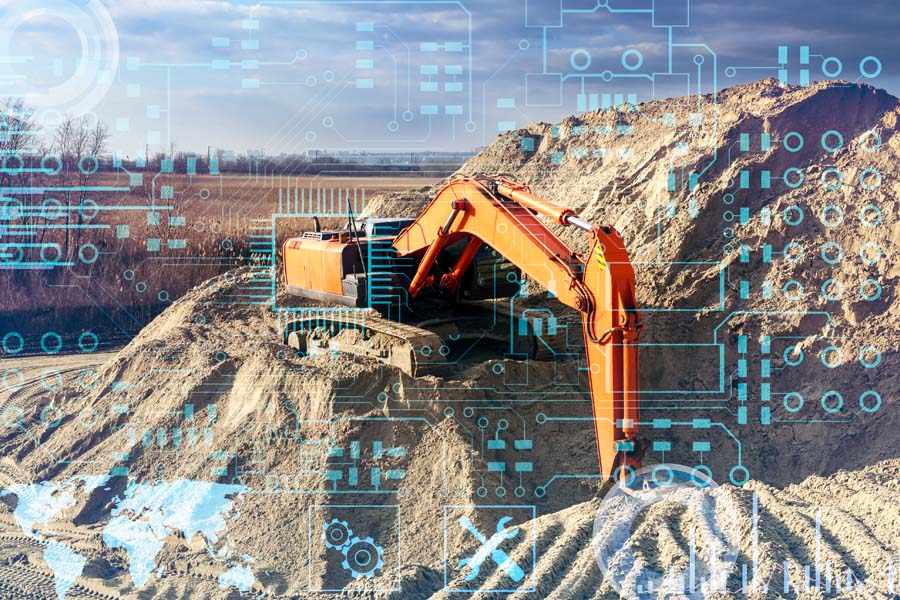It’s no secret that managers, contractors and executives in the architecture, engineering and construction (AEC) industry face mounting pressure to produce faster, do more with less and reduce waste—all while turning a healthy profit.
Already overwhelmed with everything from the skilled labor shortage to increased demand for sustainable buildings and infrastructure, most leaders in the industry probably haven’t considered how artificial intelligence (AI) could help their business. Here, two experts showcase how the technology can be applied to construction and where its application may be headed.
AI basics
Construction hasn’t adopted much by way of AI for a simple reason: the industry largely doesn’t understand the technology.
It’s hard to implement cutting-edge tools when you don’t understand them, according to Mehdi Nourbakhsh, CEO of YegaTech, a San Francisco-based consulting company focused on teaching AEC industry professionals how to grow their businesses through AI technology. “Historically, AI has been the subject of many Hollywood movies like ‘Terminator’ or ‘Ex Machina,’” Nourbakhsh said, “which created a false narrative and fear about AI taking over and governing our societies.”
In his book, “Augment It: How Architecture, Engineering and Construction Leaders Leverage Data and Artificial Intelligence to Build a Sustainable Future,” Nourbakhsh aims to cut through the noise about AI to make it more accessible. He outlines AI’s capabilities as well as its limitations and biases, so those working in construction can identify, plan and execute a successful AI project.
Getting started with AI
Nourbakhsh believes that as construction projects become more complex and customers more demanding, the technology in which scientists design computer systems that mimic human intelligence has the potential to quickly run through various scenarios, provide instant feedback about design and help industry leaders in decision-making.
After learning what AI can do, companies should find a “low-hanging-fruit project” to experiment with the technology, using it as a trial run to determine a broader AI strategy thereafter. “In my experience, whatever you put in place as your strategy before running your first project will change significantly as the project develops, so it’s better to experiment first and then define your strategy,” Nourbakhsh said.
Likening the construction industry to a group of highly skilled superheroes who power through design and construction projects, Nourbakhsh notes that as many industry professionals retire, it’s time to think strategically about new ways to approach industry challenges. He believes AI technology—if built properly—can collect and preserve valuable “superhero” knowledge, and even improve on it for future projects.
“Humans are excellent at making decisions based on limited observations, judging based on common sense, and conceptualizing, abstracting and constraining ideas,” Nourbakhsh said. “AI systems are very powerful in processing billions of data sources such as webpages, images and sound waves.”
Combining human intelligence and AI is where the magic happens, Nourbakhsh added. While humans can focus on the high-level and creative part of the process, AI systems can take on tedious grunt work.
Taking advantage of technology
AI is underused in the construction sector because the industry is heavy-labor dependent, said Ravi Bhatia, business development manager at Skanska USA Civil in East Elmhurst, New York. Few people realize that AI can be applied to address some of the sector’s biggest current challenges. “Construction is largely seen as a people-interactive process that requires constant cues and input, as the environment is unpredictable and not prone to repetition learning and predictive behaviors,” Bhatia said.
“It’s very dynamic, so a system of algorithms would not be practical to predict the behaviors,” Bhatia continued. “The uniqueness of the level of unpredictable project sites requires the uniqueness of the human mind to navigate.”
Construction companies can start by implementing equipment and mechanical support upgrades through AI-type algorithms, Bhatia said, which can improve safety performance and the environment on project sites.
“With some further research and development, it could be adaptable to quality control and assurance—these are both predictive, [recurring] and learned behaviors for which external environments can be simulated,” Bhatia said. “They’re ripe for algorithm development and AI applications.”
From pain point to profit
In his book, Nourbakhsh notes that the construction industry is slowly adopting tools like building information modeling (BIM), project management information systems, drones and virtual and augmented reality. And as improvements are made in computing and algorithms, digitization and availability of data, this is an ideal time for construction firms to invest in AI technology and even develop their own solutions.
While advising companies in the construction and manufacturing industries over the past 10 years, Nourbakhsh started seeing patterns that determined success and failure for various projects. “I wanted to share the lessons learned in these projects and help designers and construction professionals avoid the mistakes other companies made,” he said, “and I hope that by putting our hands and minds together, we could expedite change in the industry.”
For example, Nourbakhsh cites ConXtech, a construction technology company that builds small and large structures in a fraction of the time when compared to conventional steel structures using a limited number of steel beams, column sections and proprietary connections called collars. Wanting to grow its sales without investing too much in business development, the company turned to AI.
“In the discovery phase of the project, we found that employee retention, inefficiencies in cost estimating and bidding process and the long cycle of construction projects were three factors that put a lot of pressure on growing construction companies like ConXtech,” Nourbakhsh said.
“We started developing an AI solution that automates cost estimating and bidding workflows, reducing the processing time from two to four weeks to one or two days,” Nourbakhsh added. “We’ve piloted the solution in a project, and now the team at ConXtech is securing funding to scale this capability.”
Signs that a project is well-suited for AI
Skanska’s Bhatia suggests focusing on the equipment being used to perform a work function to figure out where to implement AI.
“A project would need to have a series of predictable and repetitious functions, such as cast-in-place concrete placements, formwork, reinforcement installation, installation of a specific type of retaining wall, possibly even a large earth moving function, where the equipment and operation is relatively uniform and consistent,” Bhatia said.
Nourbakhsh also advises evaluating daily tasks that AI can take over by concentrating on what you enjoy and unloading the rest.
“I work with design and construction executives to map which part of their projects gives them energy and which part drains it,” he said. “Instead of automating the entire project with AI, we can focus on automating the smaller parts that drain our energy. This is how human and AI systems work together.”
Building an AI solution is part art and part science, Nourbakhsh continued, so be open-minded while discovering the right opportunities for your business. In his book, Nourbakhsh discusses how one company combined human and AI work to reduce its carbon emissions.
“Design teams at Perkins and Will commonly have two weeks in the schematic design phase to decide on major building variables with a direct impact on environmental sustainability, and as the design develops, they need to quickly measure the impact of a design decision on the daylighting and overall energy consumption of the building,” Nourbakhsh said.
Since running energy simulations for various design options is time-consuming, designers often use instinct rather than simulation data. However, the research team at Perkins and Will developed an AI system that predicts the energy consumption of buildings in milliseconds.
“With this technology, designers can compare many different design alternatives and develop the best energy-efficient option for their clients,” Nourbakhsh said.
Future forward
One of the reasons AI is so underused in the construction sector, Nourbakhsh said, stems from there being a chasm between professionals in both fields.
“One way to bridge this gap is by making our industry more attractive to the young generations and helping them understand AEC problems,” Nourbakhsh said. “Another way is helping AEC professionals learn about data and AI, so they’ll see how relevant it is to the work they do every day.”
Of course, AI can’t solve everything. Within AI development, Bhatia sees potential along with major challenges.
“AI is clearly more difficult to adopt for heavy civil construction and state of good repair projects,” Bhatia said. “Until we can further commoditize the work, we will see a slower path in heavy construction, but a faster use of AI in vertical construction.”
“I see more opportunities in new, high-rise construction, where floor plates tend to be typical, providing avenues for repetition and scaling,” Bhatia said. “The advent of modular construction is blurring the lines between manufacturing and construction, and that presents a clear path for the growth of AI in construction.”












